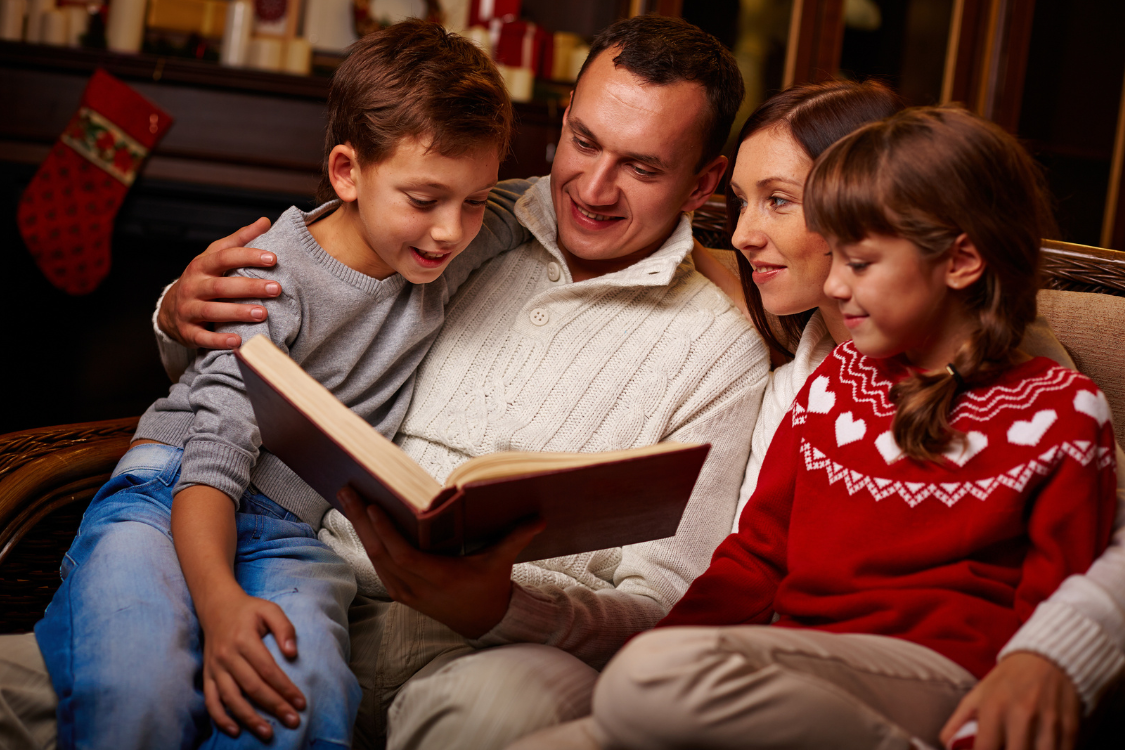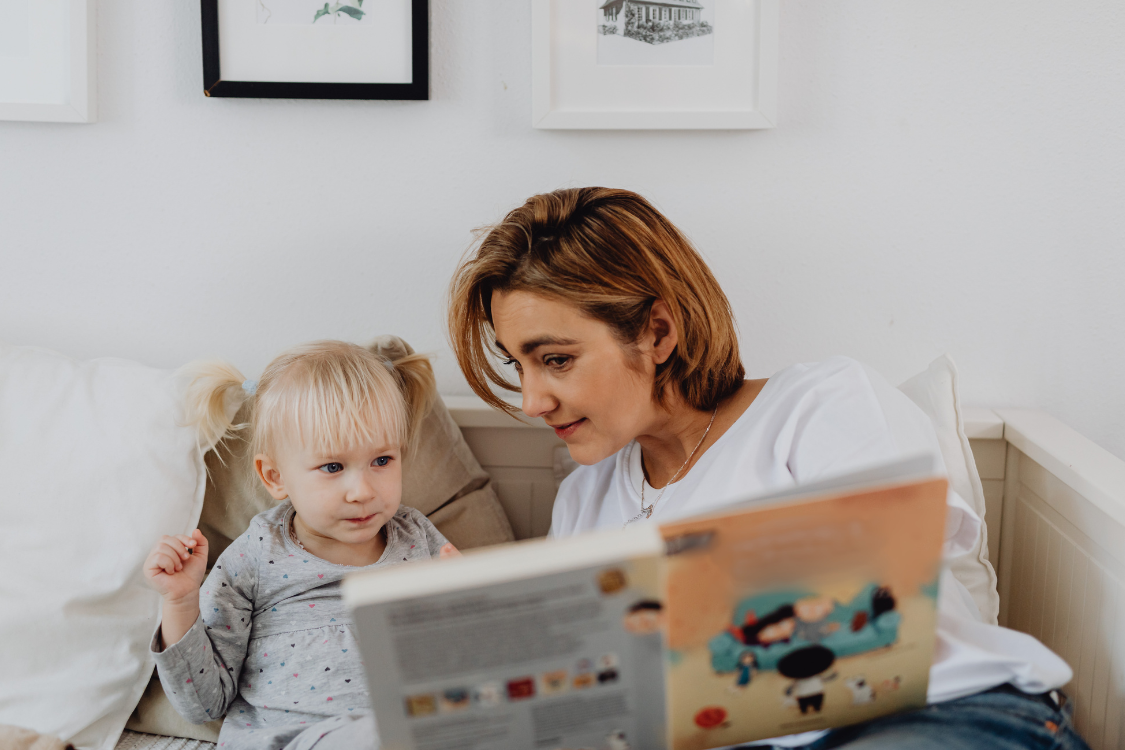Your child watches snowflakes drift past the window, clutching a mug of warm apple cider. The holiday lights glow softly in the corner. A stack of books waits on the coffee table. This is the perfect moment for reading, and your child doesn’t even realize they’re learning.
Winter offers something magical for literacy development: natural slowdowns in our usually hectic schedules. The season practically begs us to stay inside, get cozy, and spend time together. What if you could weave phonics practice seamlessly into these treasured winter moments? Not as forced lessons, but as natural extensions of the things your family already loves to do?
The beauty of embedding phonics into winter traditions is that it doesn’t feel like work. Instead, reading becomes part of the warmth and connection that makes this season special. Your child builds essential literacy skills while creating memories that last far beyond their elementary years.
Reading by the Fireplace: A Winter Anchor
There’s something almost magical about reading near a fireplace or under twinkling lights. The soft glow creates an atmosphere that makes stories feel more alive. This isn’t just about ambiance. It’s about creating positive emotional connections to reading that your child will carry forever.
Start a simple tradition: every evening after dinner, gather near your heat source (a real fireplace, a space heater, or even a video of a crackling fire on your TV) for 20 minutes of reading. Let each family member choose what to read. Your child might select a decodable book at their level, you might read from a chapter book, and older siblings can join with their own choices.
The key is making this time sacred and consistent. No phones, no interruptions. Just the warmth of the fire and the joy of stories. When reading becomes associated with comfort and togetherness, children naturally want more of it.
For emergent readers, this is your chance to model fluent reading. When your child hears you read with expression and ease, they’re learning what good reading sounds and feels like. They’re also expanding their vocabulary and comprehension skills far beyond what they can read independently.
Letter Hunts in Holiday Decorations
Your home transforms during winter with decorations, cards, and seasonal items. Each element becomes a potential phonics teaching tool when you look at it through a literacy lens. The word “JOY” spelled out in wooden letters on your mantel? That’s a phonics lesson waiting to happen.
Create a letter scavenger hunt using your winter decorations. Can your child find all the letters in their name among the holiday cards displayed on your wall? How many words can they read on the advent calendar? What sounds do they hear at the beginning of words on ornament labels?
Take it further with greeting cards that arrive throughout the season. Let your child sort cards by the first letter of the sender’s name. Practice reading names together, sounding out unfamiliar ones. “Aunt Jennifer starts with /j/. Can you find other cards from people whose names start with /j/?”
Window clings with winter scenes offer another opportunity. Point to pictures and ask your child to identify beginning sounds. “That’s a snowman. What sound does ‘snowman’ start with?” Then write the word on a fogged-up window and let them trace the letters.
Kitchen Traditions and Recipe Reading
Winter means more time baking and cooking together. The kitchen becomes a natural classroom where phonics practice happens alongside measuring cups and mixing bowls. Recipe cards aren’t just instructions. They’re reading material ideally suited for emerging readers.
Start with simple recipes your child can help read. Gingerbread cookies, hot chocolate, or simple soups work well because the ingredient lists use common words. Let your child read ingredients aloud as you gather them. “We need two cups of flour. Can you read what else we need?”
Even if your child can’t decode every word, they can find familiar sight words or practice letter sounds. “Find the word that starts with /s/. Yes, ‘sugar!’ What sound does it end with?”
Create your own simple recipe cards together with your child’s input. They can help write ingredients in large, clear letters. Keep vocabulary at their reading level when possible. Writing “milk” instead of “buttermilk” or “eggs” instead of “egg whites” makes the recipe accessible while still functional.
Some families create picture recipe cards in which children draw the ingredients next to the written words. This reinforces the connection between text and meaning. Your child practices reading the same recipe multiple times across the season, building fluency and confidence with each repetition.
Snow Day Word Families
When snow falls and school closes, turn the unexpected day off into playful phonics practice. Build word families using winter vocabulary. Start with simple words your child can read, and create related words by changing letters.
Write “snow” in the snow outside (or on a fogged window). Can your child think of rhyming words? Slow, blow, grow. Write them together and talk about how they share the same ending pattern. This is exactly how analogy phonics works, using known words to decode new ones.
Create snow word lists throughout the day. Every time your child notices something related to snow—cold, ice, white, melt—write it down. By evening, you have a collection of winter words to review. Sort them by beginning sounds or vowel patterns, depending on your child’s skill level.
Bedtime Stories With Seasonal Themes
Your regular bedtime routine probably includes reading, but winter offers chances to make it extra special. Create a rotating collection of seasonal books that only come out during these months. The anticipation of favorite winter stories builds excitement around reading time.
Choose a mix of books: some at your child’s independent reading level and others slightly above for you to read aloud. Stories about snow, hibernating animals, or winter holidays naturally engage children while teaching vocabulary specific to the season.
Here’s a powerful technique: after you read a story aloud, let your child “read” it back using a decodable version or retelling it in their own words. This builds comprehension and gives them a chance to practice story structure. “What happened first? Then what? How did it end?”
For children working on specific phonics skills, choose books that feature their current learning focus. If they’re mastering consonant blends, find stories with lots of “snow,” “sled,” and “frost” words. Point out the patterns without making it feel like a lesson. “Look at all these words that start with two consonants together!”
Create your own winter story before sleep. Take turns adding sentences, with your child contributing simple sentences using words they can read or sound out. “The snow fell down. A fox ran fast.” Write these stories down and read them together the next night. Children love reading stories they helped create.
Hot Chocolate and Decodable Books
Establish a cozy afternoon tradition: hot chocolate paired with reading time. The treat makes the reading feel special, and the routine creates structure that children find comforting. This becomes “your thing” together. A tradition your child will remember long after they’ve mastered reading.
Keep a basket of decodable books specifically for hot chocolate time. These are books where most words follow phonics patterns your child has already learned, so that they can read with confidence and success. Success matters enormously for struggling readers who need to rebuild their confidence.
Let your child choose which book to read during hot chocolate time, giving them ownership of their reading practice. Some days, they might want to read independently while you listen. Other days, they might want to take turns reading pages with you. Follow their lead.
For pre-readers or very early readers, use this time for letter-sound practice. Point to pictures in books and identify beginning sounds together. “That’s a marshmallow. /m/ /m/ marshmallow. What else do you see that starts with /m/?” The hot chocolate itself can be part of the lesson—hot starts with /h/, chocolate with /ch/.
Library Trips as Winter Adventures
When cabin fever sets in, turn library visits into special winter outings. Many libraries offer cozy reading nooks, fireplaces, or special winter programming. The trip itself becomes an adventure, and children get to choose their own books, a powerful motivation for reluctant readers.
Before you go, create a simple mission: find three books about winter, or find books with specific phonics patterns your child is learning. If they’re working on long vowel sounds, challenge them to find books with words like “snow,” “sleep,” or “freeze” in the titles.
Let your child get their own library card if they don’t have one yet. This sense of ownership and responsibility often increases interest in reading. They chose these books, they checked them out, and they’re responsible for returning them. That investment matters.
Some libraries offer free winter reading programs with small prizes or certificates for reaching goals. These external motivators can help during difficult learning phases, though the real goal is developing an intrinsic love of reading. Use programs as tools, not the main reason for reading.
After library visits, create a special display of borrowed books at home. Arrange them on a windowsill, side table, or in your reading nook. When books are visible and accessible, children naturally pick them up more often. Out of sight truly is out of mind with reading materials.
Family Game Nights With Word Games
Winter evenings are perfect for family game nights, and many games naturally incorporate phonics skills without feeling educational. Traditional board games often include reading directions, cards, or spaces that require decoding, all valuable practice.
Adapt classic games for phonics practice. Play “I Spy” with beginning sounds instead of colors. “I spy something that starts with /f/.” Fireplace, floor, fork, your child practices isolating initial sounds while playing a familiar game.
Create your own winter word bingo using vocabulary words your child is learning to read. Draw pictures alongside words so pre-readers can participate too. Call out words and have your child find and read them on their card. The repetition across multiple bingo games builds sight word recognition.
Magnetic letters or letter tiles become building toys during winter game sessions. Challenge your child to build as many three-letter words as they can in five minutes. Then work together to build four-letter words, then five-letter words. Make it collaborative rather than competitive. You’re a team working toward a goal together.
Rhyming games work beautifully around the table. Start with a winter word—”cold”—and take turns thinking of rhyming words. Write them down as you go, showing your child how words that sound alike often share spelling patterns. This builds phonological awareness alongside phonics knowledge.
Window Writing and Foggy Glass Practice
Cold winter windows naturally fog up, creating temporary writing surfaces that children find irresistible. Use this natural phenomenon for quick, playful phonics practice that feels more like magic than learning.
Write simple CVC words on foggy bathroom mirrors after showers. Your child can read them, trace them, or change one letter to make new words. Cat becomes bat becomes bit becomes sit. These quick transformations teach a crucial reading skill: changing a single letter can change the whole word.
Let your child write their own words on foggy windows. They might copy words they see around the house or try to sound out words they want to write. The temporary nature of window writing removes pressure. Mistakes simply fog over and disappear.
Create rebus puzzles on windows using drawings and letters. Draw a sun, write “-ny” next to it, and your child reads “sunny.” These puzzles teach that reading involves both recognizing words and using context clues, skills they’ll need for more complex texts later.
Some families establish a “window word of the day” tradition. Each morning, write a simple word on a foggy window. Throughout the day, family members try to use that word in sentences. By evening, the word has been read, spoken, and reinforced dozens of times.
Weave Reading Into Every Winter Moment
Winter traditions don’t just create memories. They create readers. When phonics practice is woven naturally into the cozy rhythms of the season, children develop skills without resistance or resentment. They associate reading with warmth, connection, and joy rather than struggle and obligation.
The routines you establish now can continue long after your child has mastered basic phonics. That evening, reading time by the fire? It works just as well with chapter books in third grade. Hot chocolate and books? That becomes a cherished tradition through middle school. You’re not just teaching phonics. You’re building a lifetime relationship with reading.
Ready to discover more ways to support your child’s reading development? Visit the Phonics.org blog for expert reviews of phonics programs, practical teaching strategies, and evidence-based resources that help every child become a confident reader.










